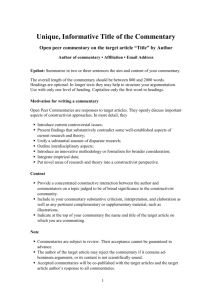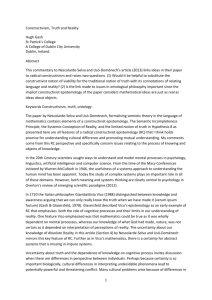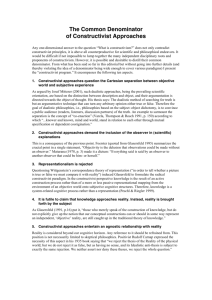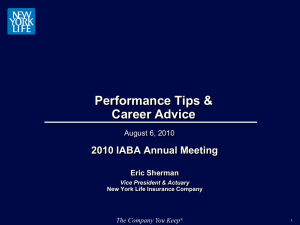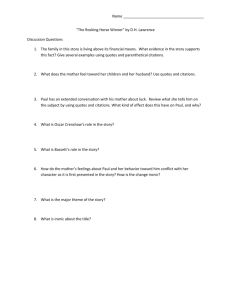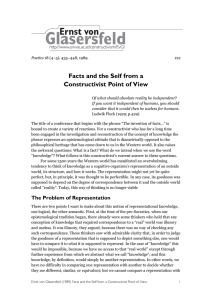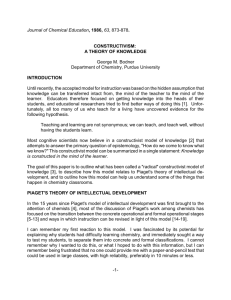title:Meaning and Description in Non
advertisement
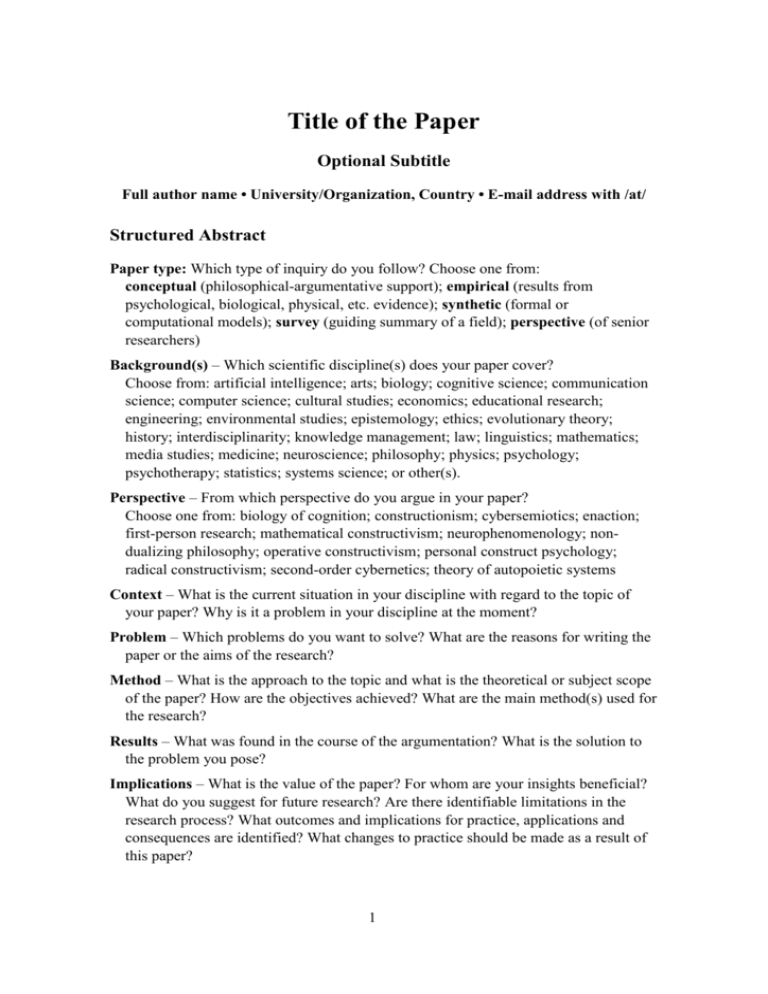
Title of the Paper Optional Subtitle Full author name • University/Organization, Country • E-mail address with /at/ Structured Abstract Paper type: Which type of inquiry do you follow? Choose one from: conceptual (philosophical-argumentative support); empirical (results from psychological, biological, physical, etc. evidence); synthetic (formal or computational models); survey (guiding summary of a field); perspective (of senior researchers) Background(s) – Which scientific discipline(s) does your paper cover? Choose from: artificial intelligence; arts; biology; cognitive science; communication science; computer science; cultural studies; economics; educational research; engineering; environmental studies; epistemology; ethics; evolutionary theory; history; interdisciplinarity; knowledge management; law; linguistics; mathematics; media studies; medicine; neuroscience; philosophy; physics; psychology; psychotherapy; statistics; systems science; or other(s). Perspective – From which perspective do you argue in your paper? Choose one from: biology of cognition; constructionism; cybersemiotics; enaction; first-person research; mathematical constructivism; neurophenomenology; nondualizing philosophy; operative constructivism; personal construct psychology; radical constructivism; second-order cybernetics; theory of autopoietic systems Context – What is the current situation in your discipline with regard to the topic of your paper? Why is it a problem in your discipline at the moment? Problem – Which problems do you want to solve? What are the reasons for writing the paper or the aims of the research? Method – What is the approach to the topic and what is the theoretical or subject scope of the paper? How are the objectives achieved? What are the main method(s) used for the research? Results – What was found in the course of the argumentation? What is the solution to the problem you pose? Implications – What is the value of the paper? For whom are your insights beneficial? What do you suggest for future research? Are there identifiable limitations in the research process? What outcomes and implications for practice, applications and consequences are identified? What changes to practice should be made as a result of this paper? 1 Constructivist content: What is the connection with constructivism? Does the paper link to one of the constructivist perspectives covered by the journal? Why it could bring progress to constructivist approaches? How it is based on the works of constructivists such as Ernst von Glasersfeld, Heinz von Foerster, Humberto Maturana, Francisco Varela, to name but a few? Do you argue in favor of a new constructivist perspective? Key Words – What are the six most important concepts and notions in the paper? Don’t repeat key words already used in the meta information. Knowledge is not passively received but actively built up by the cognizing subject (Ernst von Glasersfeld 1995: 18) Introduction 1. The introduction initializes the contact between you and your readers. You should be guided by the question, “Why should the reader get involved with my paper?” in order to provide motivation for the reader to continue. Furthermore, the introduction contains an outline of what follows in the rest of the paper. Main part of the paper 2. The main part of the paper discusses concepts, describes models, and presents results. 3. Ideas should be presented in a logical sequence – “Is there a clearly defined progression of information? Does one paragraph lead smoothly into the next?” The writing style should be simple, using as few words as possible. Conciseness and brevity are valued. Since space is limited in a journal paper stay focused on a single or a very few problems you want to solve in your paper. Do not digress from the path leading from the defined goal(s) to the presentation of results(s) and implication(s). 4. You may use as many main headings as needed, with a maximum of three levels of headers (main headers, subheaders, subsubheaders). Refrain from numbering your headings if possible. In headers, only the first word should be capitalized. 1 5. Each text paragraph should be sequentially numbered. Use the style “Numbered” for this; it can be assigned to paragraphs using the keyboard shortcut Apple-D or Control-D. Do not use paragraph numbering for headings, blocked quotes, bullet lists, the structured abstract, and entries in the References. Numbered lists, Figure and Table captions have their own sequential numbering independent of the paragraph numbering. 1 It is recommended to refrain from using too many footnotes. 2 Layout and Graphics 6. The overall length of the paper should not exceed 9000 words. To emphasize words and expressions, please use italics rather than bold typeface. As a rule, always use double quotes, never use single quotes, with the sole exception of quotes within quotes. 7. Figures (cf. Figure 1) should be included in the text and should be provided in a separate files: Scanned photos in TIFF, PNG or JPG, vector graphics in EPS or Adobe Illustrator). Photos should have a resolution of at least 200dpi. if A is… and if B is… then A or B is… true true true true false true Table 1: This is a table (or figure) caption. 8. Add first names to authors when they are mentioned for the first time; later on use only their surnames. This rule does not apply to citations where only the surnames should be used (see below). 9. Please be careful with philosophically burdened notions such as “real” and “true” and their derivatives “reality”, “really”, “truth” etc. They should be avoided unless they are the subject of the article. For example, the colloquial expression “This is true for x” can be more precisely expressed by “This applies to x”. In most cases “real” refers to “meaningful” or “genuine.” And an expression such as “In reality,…” should be replaced by “In fact,…” or “In our reading,…” etc. Language and Copyright 10. The paper must be written in English. If English is a foreign language for you, please ask a native speaker of English to proofread your article before submitting it to Constructivist Foundations. 11. The paper must be original work and must not have been published elsewhere. The copyright remains with the author and is licensed under a Creative Commons License, http://creativecommons.org. If you use copyrighted material (quotes, photographs, figures, etc.) you must obtain the permission from the respective copyright holder to reproduce the material in your paper before submitting the final version of your paper. Citing other publications 12. References to other publications should be placed in the text rather than in footnotes. They follow the simple Author Year Pagenumber format (see below for examples), and connect with a corresponding entry in the References section at the end of the paper. Use up to three authors’ surnames – otherwise the first author’s surname 3 followed by “et al.” – and the year of publication without comma between author and year. Specifications of pages are preceded by a colon in both text and reference part. 13. Short quotes can be embedded in the text; longer quotes (more than three lines) should be “blocked” as the following example shows (note also the double quotes at the beginning and the end). In any case the quote has to be accompanied by a precise citation including author’s name, year of publication, and page. Never use single quotes, neither for quotes nor for defining or emphasizing a word. Print Titles of Books in italic type rather than enclosed in quotes. “The function of cognition is adaptive; it serves the organization of the experiential world, not the discovery of ontological reality.” (Glasersfeld 1995: 18) 14. Examples: In his article “Thirty years radical constructivism,” Ernst von Glasersfeld (2005) wrote… In their book Scientific Discovery, Pat Langley et al. (1987: 103) showed that … “… quoted text.” (O’Regan & Noë 2001: 940). Future directions [optional] 15. In this optional section you may provide and discusses a list of research topics that could be tackled next by the scientific community – “What could be done next?” Conclusion 16. The obligatory section summarizes the paper. Let yourself be guided by the question, “What main points did I make, what did I show?” 17. The concluding section should also discuss the relevance of the discussion or results presented, emphasizing the question, “How is my paper related to constructivist approaches?” The Conclusion should involve critical thinking so reflect upon the significance of what you have written. Convey some closing thoughts about the larger implications of your argument and leave the reader with something to think about upon which further research could be built. References Examples of references; here, important elements are shown in red. Brook A. (2008) Kant’s view of the mind and consciousness of self. In: Zalta E. N. (ed.) The Stanford encyclopedia of philosophy. Available at http://plato.stanford.edu/entries/kant-mind/ Foerster H. von (1984) On constructing a reality. In: Watzlawick P. (ed.) The invented reality. W. W. Norton, New York: 41–62. Foerster H. von (2003) Molecular ethology: An immodest proposal for semantic clarification. In: Foerster H. von, Understanding understanding. Springer, New York: 4 133–168. Originally published in: Ungar G. (ed.) (1970) Molecular mechanisms in memory and learning. Plenum Press, New York: 213–248. Glasersfeld E. von (1995) Radical constructivism: A way of knowing and learning. Falmer Press, London. Glasersfeld E. von (2005) Thirty years radical constructivism. Constructivist Foundations 1(1): 9–12. Available at http://www.univie.ac.at/constructivism/journal/1/1/009.glasersfeld Langley P., Simon H., Bradhaw G. L. & Zytkow J. M. (1987) Scientific discovery. MIT Press, Cambridge MA. Maturana H. R. (1978) Biology of language: The epistemology of reality. In: Miller G. A. & Lenneberg E. (eds.) Psychology and biology of language and thought. Academic Press, New York: 27–63. O’Regan J. K. & Noë A. (2001) A sensorimotor account of vision and visual consciousness. Behavioral and Brain Sciences 24(5): 939–1031. Piaget J. (1954) The construction of reality in the child. Ballantine, New York. Originally published in French as: Piaget J. (1937) La construction du réel chez l’enfant. Délachaux & Niestlé, Neuchâtel. The author Biographical sketch of the author(s), about 50–200 words List of potential independent reviewers 1. Name, email, affiliation, relevant expertise 2. Name, email, affiliation, relevant expertise 3. Name, email, affiliation, relevant expertise 4. Name, email, affiliation, relevant expertise 5. Name, email, affiliation, relevant expertise 5
